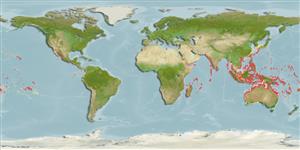Common names from other countries
>
Gobiiformes (Gobies) >
Gobiidae (Gobies) > Gobiinae
Etymology: Oplopomus: Greek, hoplon = weapon + Greek,poma, -atos = cover, operculum (Ref. 45335).
More on author: Valenciennes.
Environment: milieu / climate zone / depth range / distribution range
นิเวศวิทยา
เกี่ยวกับทะเล,น้ำเค็ม เกี่ยวกับหินโสโครก; ระดับความลึก 1 - 30 m (Ref. 1602), usually 1 - 20 m (Ref. 27115). Tropical; 22°C - 29°C (Ref. 27115)
Indo-Pacific: East Africa to the Society Islands, north to the Ryukyu Islands (Ref. 559).
ขนาด / น้ำหนัก / Age
Maturity: Lm ? range ? - ? cm
Max length : 10.0 cm SL เพศผู้/กระเทย; (Ref. 48637)
Short description
เครื่องมือที่ใช้ในการแยกชนิดสัตว์,สิ่งมีชีวิตออกจากกัน | สัณฐานวิทยา | ความยาวต่างๆ
เงี่ยงครีบหลัง (รวม) : 7; ก้านครีบอ่อนที่หาง (รวม) : 10; เงี่ยงครีบก้น: 1; ก้านครีบอ่อนที่ก้น: 10. Males with more intense blue spots on the head and more colorful markings on fins than females; subadults lack the blue and yellow spotting but have more black spots (Ref. 1602); characterized further by having forth and fifth dorsal spines prolonged in male and may have filamentous tips; strong and sharp tipped first spine of each dorsal fin; united pelvic fins, well developed frenum present; rounded caudal fin, shorter than head length; longitudinal scale series 29-30; predorsal scales about 13; mainly ctenoid scales on body; cycloid scales on prepectoral area, breast and abdomen; preopercular margin just above angle with 1-3 small spines; depth of body 4.0-4.6 in SL (Ref. 90102).
Inhabits silty bottoms of inner lagoons and bays (Ref. 9710). Solitary or in pairs (Ref. 90102). Also occurred in shallow to deep coastal sand and mud flats, usually on the sand near large depression with burrow in the middle (Ref. 48637).
Life cycle and mating behavior
Maturities | การสืบพันธุ์ | Spawnings | Egg(s) | Fecundities | ตัวอ่อน
Randall, J.E., G.R. Allen and R.C. Steene, 1990. Fishes of the Great Barrier Reef and Coral Sea. University of Hawaii Press, Honolulu, Hawaii. 506 p. (Ref. 2334)
IUCN Red List Status (Ref. 130435)
CITES (Ref. 128078)
Not Evaluated
Threat to humans
Harmless
Human uses
การประมง: การค้า; สถานที่แสดงสัตว์และพืชน้ำ: การค้า
เครื่องมือ
Special reports
Download XML
แหล่งที่มาจากอินเตอร์เน็ต
Estimates based on models
Preferred temperature (Ref.
115969): 24.7 - 29, mean 27.8 (based on 1054 cells).
Phylogenetic diversity index (Ref.
82804): PD
50 = 0.7500 [Uniqueness, from 0.5 = low to 2.0 = high].
Bayesian length-weight: a=0.01023 (0.00477 - 0.02194), b=3.02 (2.84 - 3.20), in cm Total Length, based on LWR estimates for this (Sub)family-body shape (Ref.
93245).
ระดับชั้นอาหาร (Ref.
69278): 3.4 ±0.4 se; based on size and trophs of closest relatives
ความสามารถในการกลับคืนสู่ปกติ (Ref.
120179): ความสูง, เวลาต่ำสุดที่จะทำให้ประชากรเพิ่มขึ้นเป็น 2 เท่าใช้เวลาน้อยกว่า 15 เดือน (Preliminary K or Fecundity.).
Fishing Vulnerability (Ref.
59153): Low vulnerability (10 of 100).
